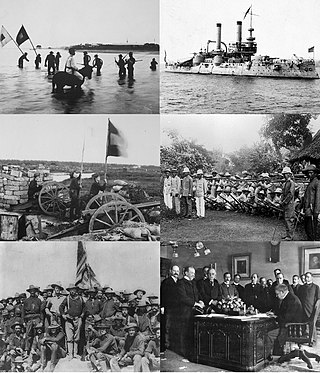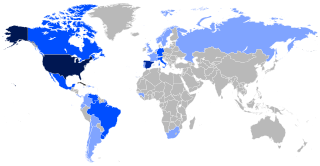Related Research Articles

The Spanish–American War began in the aftermath of the internal explosion of USS Maine in Havana Harbor in Cuba, leading to United States intervention in the Cuban War of Independence. The war led to the United States emerging predominant in the Caribbean region, and resulted in U.S. acquisition of Puerto Rico, Guam, and the Philippines. It also led to United States involvement in the Philippine Revolution and later to the Philippine–American War.

The national flag of Cuba consists of five alternating stripes and a red equilateral triangle at the hoist, within which is a white five-pointed star. It was designed in 1849 and officially adopted May 20, 1902. The flag is referred to as the Estrella Solitaria, or the Lone Star flag. It is in the stars and stripes flag family.

Cubans are people from Cuba or people with Cuban citizenship. Cuba is a multi-ethnic nation, home to people of different ethnic, religious and national backgrounds.

José Ariel Contreras Camejo, is a Cuban former professional baseball pitcher, who played in the Cuban National Series (CNS), Major League Baseball (MLB), and internationally for the Cuban national baseball team. He also played in the Chinese Professional Baseball League (CPBL) for the Chinatrust Brothers.
The inaugural season of the Cuban National Series was won by Occidentales, composed largely of players from Pinar del Río.
Industriales began to make a habit of Cuban National Series titles during the 1964-65 season, the fourth installment of Cuba's new post-revolutionary amateur baseball league. The team, representing Havana, won its third straight title.
The 10th season of the Cuban National Series ended with Azucareros taking the title, finishing just ahead of a group including Habana, Granjeros and Industriales.
The 14th Cuban National Series was won by Agricultores, a team from Havana, who finished just one game ahead of two other teams. The short season of 39 games coincided with the first Selective Series, a sort of domestic all-star league for Cuban baseball players. While the size of the league remained the same as during the prior season, half of the teams in the league changed.
The 15th Cuban National Series was won by Ganaderos, representing the province of Camagüey. They finished the season with all other teams more than five games behind. The length of schedule and the teams within the league remained the same as the prior season.
In the 19th season of the Cuban National Series, Santiago de Cuba won its first title, edging Villa Clara, Forestales, and Vegueros, each of which finished within two games of the champion. The league's 18 teams and 51-game schedule remained unchanged from the prior season.
In the 21st season of Cuban National Series, Vegueros, from Pinar del Río Province, repeated as champions, finishing with a one-game lead over Citricultores, from Matanzas Province. Metropolitanos finished well ahead of its Havana rival, Industriales. The league's teams and length of schedule remained unchanged from the prior season.
The 32nd season of the Cuban National Series saw a slight contraction of the league. Two of the Cuban provinces that had been fielding two teams each since the 1977–78 season, Pinar del Río Province and Matanzas Province, began fielding one team each. Vegueros and Forestales became the Pinar del Río team, while Henequeneros and Citricultores became the Matanzas team. Ciudad de La Habana Province continued to field two teams, Industriales and Metropolitanos.
The 33rd Cuban National Series saw further dominance from the previous year's group winners: Pinar del Río, Industriales, Villa Clara and Santiago de Cuba. Among them, only Pinar del Río won its group by fewer than seven games, in a 65-game season.
Santiago de Cuba won its third straight Cuban National Series crown, under manager Higinio Vélez.
The 39th Cuban National Series was marked by Santiago de Cuba's remarkable postseason run to win its second straight National Series. Under the direction of manager Higinio Vélez, the Avispas won eleven straight games in the playoffs, sweeping Camagüey, Granma and finally Pinar del Río.
The 36th Cuban National Series saw Pinar del Río post the league's best regular-season record. In the playoffs, the Vegueros, led by Omar Linares, went undefeated, sweeping both best-of-seven series.
The 26th Cuban National Series was the second season the league held a postseason round-robin tournament to determine a champion. The four teams that qualified were the same as in the prior season: Vegueros from Pinar del Río Province, Industriales of Havana, Santiago de Cuba, and Villa Clara. Vegueros captured the championship by winning five of their six postseason games. The league's 18 teams and 48-game regular-season schedule were unchanged from the prior season.
In the 27th season of the Cuban National Series, Vegueros, from Pinar del Río Province, repeated as champions. La Habana and Santiago de Cuba both won at least 80% of their regular-season games, but Vegueros, with an all-star lineup including Luis Casanova and Omar Linares, prevailed in the postseason. Camagüey advanced to the four-team round-robin tournament for the first time, but lost all but one of their games. The 18 teams within the league, each playing a 48-game regular-season schedule, remained unchanged from recent seasons.
The 28th season of the Cuban National Series saw a three-way tie atop the Eastern division, with Granma and Santiago de Cuba advancing to the postseason, along with Industriales and Henequeneros from the Western division. The ensuing round-robin tournament was won by Santiago de Cuba, who won five of their six games. This was the final season with the postseason structured as a round-robin tournament. The 18 teams of the league, each with a 48-game regular-season schedule, was unchanged from recent seasons.
In the 29th season of the Cuban National Series, the postseason format was changed. The league directly matched its two division winners in a best-of-seven series for the league championship, while the two division runners-up played a best-of-five series for third place. A four-team round-robin tournament had previously been used, since the 1985–86 season. The 18 teams of the league, and the regular-season schedule of 48 games, remained unchanged.
References
- ↑ "Las 40 primeras Series Nacionales". Granma (in Spanish). Archived from the original on December 27, 2014.